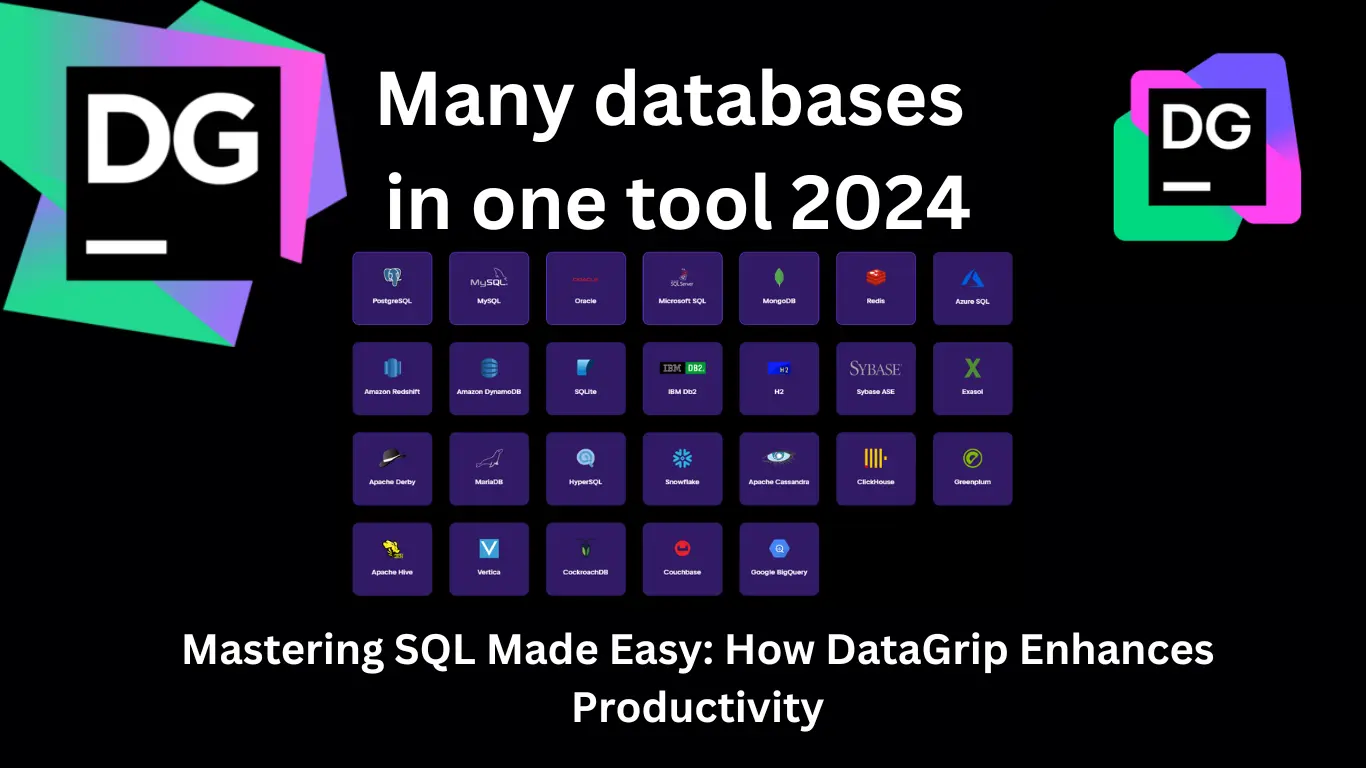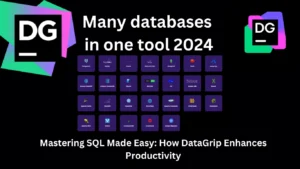DataGrip Introduction-
DataGrip In today’s data-driven world, the ability to efficiently manage databases is essential for developers, analysts, and data engineers. SQL, the standard language for interacting with databases, is fundamental to these roles. However, writing and managing SQL queries by hand can become cumbersome, especially with complex databases. This is where DataGrip steps in—a powerful and user-friendly graphical user interface (GUI) tool from JetBrains that enhances productivity when working with SQL databases. In this article, we’ll explore DataGrip’s key features, benefits, and how it simplifies database management.
———————————————————————————————————————————
What is DataGrip?
DataGrip is an Integrated Development Environment (IDE) designed for database professionals. Whether you’re working with relational databases like MySQL, PostgreSQL, or enterprise solutions like Oracle and SQL Server, DataGrip provides a unified interface to help you interact with them efficiently. As a JetBrains product, it carries the same reputation for quality as other popular JetBrains tools such as IntelliJ IDEA and PyCharm.
With features ranging from SQL code completion and error detection to schema navigation and database exploration, DataGrip offers much more than a simple query editor. Its intelligent design saves time, improves code quality, and allows database professionals to focus on solving problems rather than struggling with syntax or workflow issues.
———————————————————————————————————————————
Why DataGrip is Trending in 2024
In 2024, the importance of data in businesses is at an all-time high. Teams need faster, smarter ways to manage databases and generate insights. Data Grip fits into this narrative by offering robust database tools that are easy to use.
The growing popularity of remote work has also accelerated the adoption of cloud-based databases like Azure and Amazon RDS—which Data Grip supports. As more teams rely on remote collaboration, a tool like Data Grip ensures that database workflows are smooth, no matter where the team is located.
———————————————————————————————————————————
Key Features of DataGrip
1. Multi-Database Support
One of DataGrip’s greatest strengths is its ability to connect with multiple databases simultaneously. It supports a wide range of databases, including:
- MySQL, PostgreSQL, and SQLite
- Microsoft SQL Server
- Oracle, MariaDB, and others
This flexibility allows developers to manage different databases within the same tool, eliminating the need to switch between multiple platforms.
———————————————————————————————————————————
2. Smart SQL Code Completion
Writing SQL becomes faster and more efficient with DataGrip’s intelligent code completion. It suggests the most relevant keywords, table names, and column names as you type. This is especially helpful when working with large databases where remembering every table name or column can be challenging.
———————————————————————————————————————————
3. Error Detection and Debugging
DataGrip catches SQL errors on the fly, underlining mistakes as you write your queries. This instant feedback prevents syntax errors from slipping into production and saves time during development. It also offers a built-in debugger to help diagnose complex query issues.
———————————————————————————————————————————
4. Data Visualization and Table Editing
With DataGrip, viewing and editing data is simple. It provides an intuitive table editor that allows you to modify data directly from the GUI. You can also export query results into formats like CSV or JSON. Additionally, visualizing data relationships and dependencies becomes easier with its diagram generation feature, which displays links between tables.
———————————————————————————————————————————
5. Version Control Integration
DataGrip supports version control systems like Git, making it easy to manage changes in SQL scripts. This is particularly useful for teams that collaborate on complex database projects, as it ensures everyone is working with the latest version of the code.
———————————————————————————————————————————
6. Customizable Query Execution
DataGrip provides the flexibility to run specific parts of your queries instead of executing the entire script. This makes testing smaller code blocks much more efficient. It also keeps a history of your executed queries, so you can easily revisit previous queries without rewriting them.
———————————————————————————————————————————
Benefits of Using DataGrip
1. Enhanced Productivity
With intelligent code completion, instant error detection, and schema exploration tools, Data Grip eliminates many of the tedious tasks associated with SQL development. This allows users to focus on building solutions and analyzing data rather than fixing small mistakes or searching through documentation.
———————————————————————————————————————————
2. Reduced Learning Curve for Beginners
For developers or analysts new to SQL, Data Grip offers a more accessible way to work with databases. Its intuitive interface and helpful suggestions speed up the learning process, making it easier to get started with SQL queries.
———————————————————————————————————————————
3. Seamless Collaboration for Teams
With features like version control integration and query history, Data Grip ensures that teams can collaborate effectively. Developers working on the same SQL scripts can stay synchronized and avoid version conflicts.
———————————————————————————————————————————
4. Unified Tool for Multiple Databases
Switching between different database clients can be frustrating, especially for developers working with multiple technologies. Data Grip offers a one-stop solution by supporting a variety of database systems under a single interface.
———————————————————————————————————————————
How DataGrip Stands Out from Other SQL Tools
There are many SQL tools available, ranging from simple query editors to advanced database management platforms. Here’s how Data Grip differentiates itself:
- Focus on SQL Development: Unlike generic database tools, Data Grip is optimized for writing, debugging, and managing SQL code.
- Deep Integration with JetBrains Ecosystem: If you’re already using JetBrains tools for software development, Data Grip fits seamlessly into your workflow.
- Frequent Updates: JetBrains actively maintains Data Grip with frequent updates, ensuring compatibility with the latest database technologies.
- Advanced Features in a User-Friendly Interface: While some tools offer powerful features, they often come with a steep learning curve. DataGrip strikes a balance between power and usability.
———————————————————————————————————————————
Potential Drawbacks of DataGrip
While DataGrip is a robust tool, it may not be the perfect fit for every scenario:
- License Costs: Data Grip is a paid tool, which might not suit users or organizations with limited budgets. However, JetBrains offers flexible pricing plans and a free trial to evaluate the product.
- Resource Intensive: As a feature-rich IDE, Data Grip can be heavy on system resources, especially when working with large datasets or multiple databases.
- Not Ideal for Casual Users: If you only need to run occasional queries, simpler SQL tools or web-based query interfaces might be more practical.
———————————————————————————————————————————
Who Should Use DataGrip?
DataGrip is ideal for:
- Database administrators (DBAs) managing complex environments.
- Developers working on applications with multiple backend databases.
- Data analysts who need a powerful SQL query editor for data exploration.
- Teams requiring collaborative SQL development with version control.
———————————————————————————————————————————
Getting Started with DataGrip
Setting up DataGrip is straightforward:
- Download and Install: Visit the official DataGrip website and download the installer for your operating system.
- Configure Database Connections: Add your database credentials to connect Data Grip with your SQL servers.
- Start Querying: Use the editor to write and execute SQL queries, explore schemas, and visualize relationships between tables.
JetBrains offers comprehensive documentation and tutorials, making it easy to get up and running quickly.
———————————————————————————————————————————
Pricing and Availability
Data Grip is part of JetBrains’ family of products. It offers a 30-day free trial, after which users can subscribe to monthly or annual plans. Educational institutions and open-source contributors can often access discounts or free licenses.
———————————————————————————————————————————
Conclusion
DataGrip is a powerful and versatile SQL IDE that simplifies database management and SQL development. Whether you are working with MySQL, PostgreSQL, or enterprise-grade solutions like Oracle, Data Grip offers a feature-rich platform to streamline your workflow. Its intelligent code completion, error detection, and multi-database support make it an essential tool for developers, analysts, and database administrators alike.
If you’re looking for a reliable and efficient way to manage SQL queries and databases, Data Grip is worth considering. With its intuitive interface and JetBrains’ commitment to quality, it offers everything you need to boost productivity and reduce the complexity of database management.
———————————————————————————————————————————
Users appreciate its intuitive interface, ability to support multiple databases in one tool, and advanced autocomplete for SQL queries.
It connects to platforms like MS SQL, MySQL, PostgreSQL, MongoDB, and more.
DataGrip offers better UI customization, robust query management, and cross-database querying but may lack some SQL Server-specific tools found in SSMS.
It is widely used by SQL professionals and large enterprises due to its scalability across various platforms

